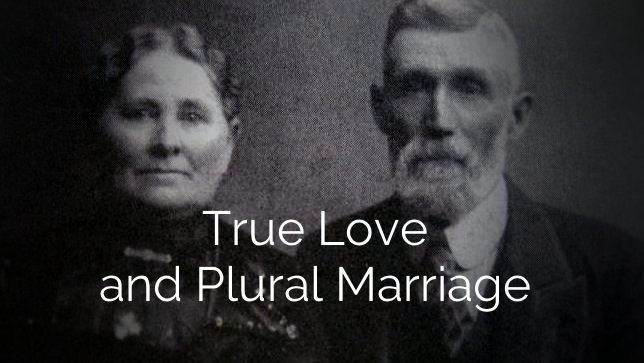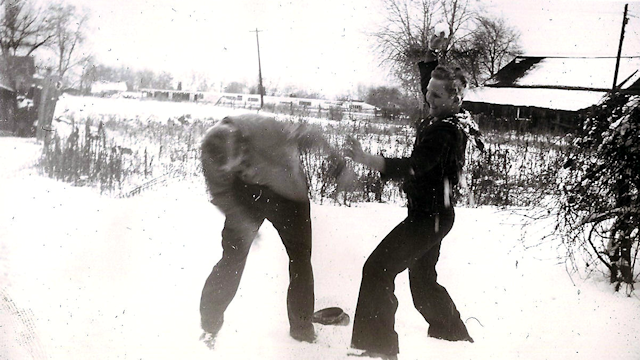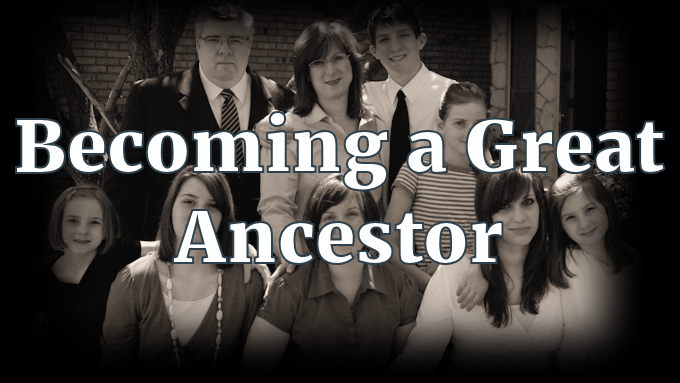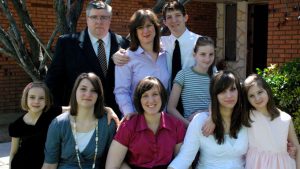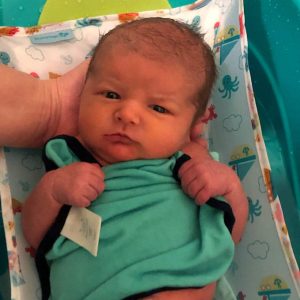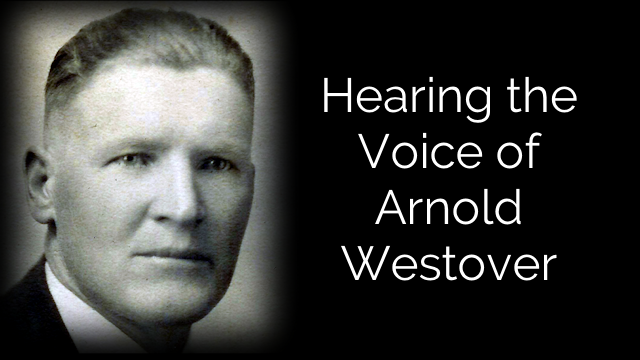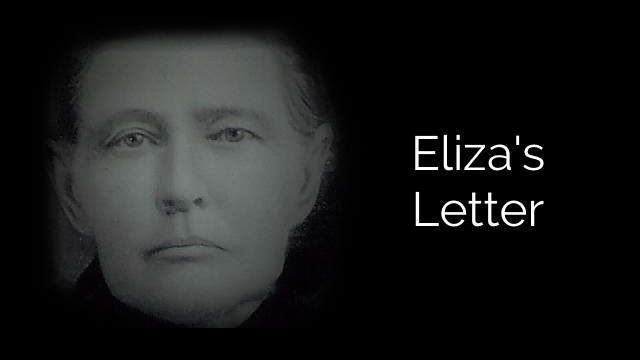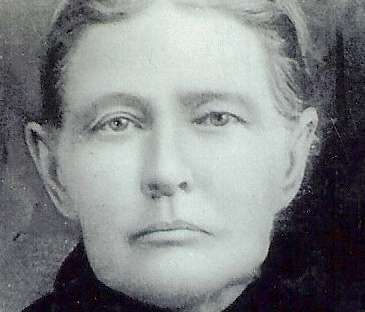True Love and Plural Marriage
It is the time of year when my mind wanders to the beautiful cemeteries of Cache Valley. In the years I have lived here I have learned to love these sacred places and the memories of those who rest in peace here.
I logged on to Family Search this week not expecting to learn of another family member buried nearby.
My feed on Family Search showcased newly uploaded photos of one Anna Clark Hale, who rests now in the cemetery in Preston, Idaho – just about 20 miles north of where I now reside.
But is she really family? Well, yes…and no.
(I’m claiming her anyway and this year I will bring her flowers, too).
Anna Clark is listed on Family Search as the fourth wife of James Chauncey Snow – my fourth great grandfather through the Snow line.
James Chauncey Snow was the son of Gardner Snow, who joined the Church very early.
By the time James was around 40 years of age he found himself to be a stake president in Provo, Utah.
This is where he met and allegedly married Anna Clark in March of 1857. She was just 16 years old.
To the uninformed, this seems a very odd and even disturbing thing.
What business does a 40-year old man have marrying a 16 year old girl? And yet, there it is, a footnote for both of these 19th century people in our family tree.
I decided to check it out.
After all, Anna Clark was the first of many women in our tree who married at precisely that same time.
~ Lots of Marrying Going On ~
I will leave the history and the debate of the Mormon practice of plural marriage to the experts. For the purposes of this discussion, I only want to point out the facts as it relates to our family in the 19th century.
The fact remains that between September of 1856 and September of 1857 a great number of our ancestors married and many of them were in plural spouse situations.
Ann Findley (age 17), fresh after arriving by handcart from Scotland in September 1856, married Edwin Westover in February 1857. Edwin was 33 years old.
His brother, Charles Westover, took Mary Shumway (age 21) to wife the same month.
It wasn’t just the very young who married either.
Albert Smith married Sophie Petersen, age 34 and already a mother to 7 children, as his 2nd wife in Manti, Utah.
The Denmark-born Ane Marie Jensen (age 24) married Samuel Barnhurst around the same time.
Even James Chauncey Snow entered into plural marriage around this time. Although already married to Eliza Ann Carter for 18 years in February 1856 he married Lydia Chadwick (age 38) and in December of that same year he married Jane Cecelia Roberts (age 20). (It was from this union with Jane Cecelia Roberts that we descend).
So why all the marrying?
And why did all the plural marriage arrangements listed above endure — except for James C. Snow and Anna Clark?
~ The Mormon Reformation ~
Each of the individuals listed above were caught up in the trials and times of Utah Territory and specifically in LDS church history during the years of 1855-1857. It is a complicated tale.
The years 1847 and 1848 were the years of the first Mormon immigrants in the territory. We know well their struggle for survival those first few years. They lived in forts, tents and wagons as they scratched out a desperate existence in the desert valley of the Great Salt Lake.
The gold rush of 1849 brought visitors, cash, supplies and new immigrants to the valley.
As they came and stayed, or came and passed through, the valley prospered. Farms were established, new settlements were explored, and the desert slowly began to “blossom as a rose”.
In fact, after the drama of the seagulls, and the first walls of territorial forts went up, there came an eventual and steady kind of rugged prosperity to Utah Territory.
Winters were harsh but leaders continually encouraged industry and the people began to thrive.
But the years of 1854 and 1855 brought drought and famine – and things got a little rough.
As church leaders juggled concerns with Indians, the food supply, and a steady stream of immigrants they began to feel a lacking of the faith of the people.
Starting in the spring of 1856 they began to call the people of Utah to repentance.
This period of time is now known as the Mormon Reformation.
A great deal has been written about this time frame and what I share here is not meant to displace anything put out there by historians.
I only mention the Mormon Reformation in context of the individuals listed above and how this time frame affected their choices – and thus our very existence as their offspring.
With this call to repentance came an invitation to be re-baptized and to earnestly seek living the higher laws of the gospel.
One of those laws was plural marriage.
Again, I’ll leave it to the historians to lay out all the facts of how plural marriage came about in the Church. It was practiced on a very limited basis in Nauvoo but was not revealed to the world at large, including most of the Church membership, until 1852.
Even then, only a very small percentage of church members were engaged in the practice — until the Mormon Reformation of 1856-57.
Just as many – such as Electa Westover – rushed to the waters for re-baptism, so too did many apply to practice plural marriage – including all the people listed above – and also allegedly including James C. Snow, the 40 year old Stake President of Provo and Anna Clark, the 16 year old pioneer girl from Provo.
~ But what about love? ~
The story of Anna Clark and her family is typical. Her parents joined the church in the 1830s, experienced persecution for their faith everywhere they went and eventually found their way to Nauvoo.
There they saw their family split up as two older brothers soon joined the Mormon Battalion and the rest of her large family had to make their way across the plains after a difficult experience at Winter Quarters.
They made it to Utah after some trial and loss (three of the Anna’s siblings died on the way) and settled in the Provo area.
As a teenager in the Provo area during the 1850s Anna had an active experience mixing church and family. As was typical, she was engaged in the work of survival with the rest of her family.
When she was thirteen years old a boy two years older than her came to work the family farm over the course of a summer.
For hours they would herd, tend and milk cows, often “talking love” after they came to know each other. They had a small book they hid in a tree that they would use to trade messages with each other.
According to her memoir Ann and this fifteen year old boy pledged to marry each other once they were old enough to do so.
For the next several years she kept tabs on her beau, even though she came to understand that her parents were not keen on him.
They thought Solomon Hale “too wild” for their young Anna.
There were reasons aplenty for parents to safeguard their daughters. While Solomon Hale was just a teenager himself he was far from the only concern for the parents of Ann Clark.
In fact, there was real danger for nearly all young women in the territory.
“Keeping the women safe” was more than a motto after the depredations of Missouri.
In fact, between the hostile natives and the ever-shifting immigrant population of Utah it was observed by many that the overall population of Utah kept their women folk well protected.
But for young Anna Clark it was set in her mind just where her future would lie – and with whom. She was, after all, in love.
~ The Three Phases of the Mormon Reformation ~
According to historians, there were three phases of the Mormon Reformation.
Over the summer of 1856 Brigham Young and other church leaders traveled the different settlements in the territory preaching repentance and encouraging the congregations to elevate their spiritual lives.
When this effort didn’t seem to achieve the desired results a 2nd phase of the Reformation began that “rained down pitchforks” on the Latter-day Saints. Many historians call it a period of hellfire and damnation preaching in Mormon church meetings.
They called upon the Saints to improve their homes, lots and farms. They encouraged better church attendance. They discouraged excessive singing and dancing and encouraged more frequent prayers. They wanted the Saints to “wake up” spiritually.
The 3rd phase of the Reformation really began at the October General Conference of the Church when Brigham Young stopped the proceedings to organize the rescue of the handcart companies still out on the plains.
It took nearly two months to bring them in and the whole experience tempered the Reformation movement, giving it a gentler tone and an emphasis on compassion.
This time of compassionate messaging led to an increase in plural marriages. This was, after all, a season for marrying for pragmatic reasons.
For example, Sophie Petersen was a single mother member of the Willie Handcart Company who had four of her surviving children to care for when she arrived penniless in Utah.
She needed a husband and needed one quickly. Albert Smith raised his hand in response to the call as one who would be willing to marry her.
The same was true of Ane Marie Jensen, who arrived from Denmark during this period. When she was introduced to Samuel Barnhurst during a church meeting they couldn’t even converse due to the language barrier.
Women of these situations were placed in plural wife arrangements because there simply were few eligible single men — and no time – for them to court.
But even the younger women like Ann Findley, Mary Shumway, and, yes – Anna Clark – were in demand from those older men who were eager to show an increase in their faithfulness through plural marriage.
These young women likewise were willing participants in the call to greater obedience. Love of God had far more to do with it than anything else.
~ On the March ~
The Mormon Reformation soon ran out of steam, however, due to a new crisis in the territory.
In the summer of 1857 – while celebrating 10 years in the valley – Brigham Young and the Saints learned of the march of Johnston’s army.
This event affected nearly every community in the territory.
Anna Clark – now supposedly married to President James Chauncey Snow of the Provo, Utah Stake – knew it better than anyone. Anna wrote:
“…The Saints were all ordered by President Brigham Young, those living in Salt Lake City and all the settlements north and west, to leave their homes and move southward, which they did as soon as spring opened, settling mostly in the Provo area.
So, when Johnston lead his army through Salt Lake City, last of June, he found it deserted. But history tells this story.
However, history doesn’t tell the story of thousands of girls who lived through it all like I did.
I was 17 in April of that year, and it’s easy to remember how the Saints came flocking into Provo by the thousands, pitching their tents, camping in covered wagon-beds on the ground, throwing together make-shift log cabins, etc – many going on to Springville and parts near-by.
I want to tell you that this was a time when we girls had to stay close to home, and never be caught out alone anywhere.
Johnston’s Army set up what looked like a rather permanent encampment west of where the town of Lehi is now situated, which they named Camp Floyd. And the officers and soldiers were coming into our town thick as bees and were hot after the girls….”
Interestingly the memoir of Anna Clark fails to ever mention her sealing to President James Chauncey Snow around this time.
In fact, James Chauncey Snow’s history fails to mention her either.
So where did this phantom polygamous marriage of a 16 year old pioneer girl to a 40 year old Stake President come from?
~ Family Stories Lacking Evidence ~
Both James C. Snow and Anna Clark Hale have on their profile pages of Family Search a tie to each other, dating from March 13, 1857.
The note there says that according to a history written by a great-granddaughter, Myrlene Snow Woodbury, James Chauncey Snow and Anna Clark were married in his office in Provo, Utah.
The marriage supposedly lasted six years, resulted in no children, and dissolved when Anna divorced James and married Solomon Hale.
In fact, the history purportedly states that James Chauncey Snow went to prison because of this union, incarcerated for living polygamy.
But there are no other sources than this written history. There are no official records of the marriage.
I’m torn about it all.
Without any kind of records – or mention in their personal writings about each other – I’m inclined to doubt this ever happened.
However, Myrlene Snow Woodbury was no slouch as a family historian.
Her work in the history of the Snow family is something of legend. While she didn’t source this story it is clear that she had heard this story from someone.
While I will as a matter of interest continue to pursue evidence, either for or against this story, I fear there is no way in this life we can know the truth of the matter.
However, with perfect hindsight that comes from people dead now for more than a century, we do know the rest of the story.
And the story is this: both James Chauncey Snow and Anna Clark Hale were incredible people, even if their lives only crossed each other briefly.
~ Who was James Chauncey Snow? ~
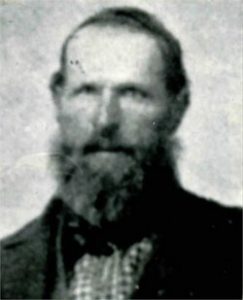 James Chauncey Snow was the son of Gardner and Sarah Snow, early converts to the LDS faith. He was baptized in to the church as a 16 year old. When he was 19 he served a mission in the New England states and received a Patriarchal blessing under the hands of Joseph Smith Sr. in Kirtland, Ohio in 1837.
James Chauncey Snow was the son of Gardner and Sarah Snow, early converts to the LDS faith. He was baptized in to the church as a 16 year old. When he was 19 he served a mission in the New England states and received a Patriarchal blessing under the hands of Joseph Smith Sr. in Kirtland, Ohio in 1837.
He married Eliza Ann Carter in 1838, traveled to Missouri and eventually settled in Nauvoo, where he became a member of the Nauvoo Legion.
He remained active in the Church and even in local politics. He was away on another mission when the Prophet Joseph and his brother Hyrum were martyred. He left Nauvoo with his family in 1846 and made it as far as Council Bluffs, where they remained in 1852. He then captained his own company, arriving in the fall of 1852 and settling in Provo in 1853, where he was called to serve as Stake President.
While in this position James C. Snow also served as a member of the territorial legislature and as a United States deputy marshal. He was also elected as a surveyor of Utah County.
As Stake President, there is no doubt that when visiting church authorities came to preach in church congregations near Provo that James C. Snow was there. He likely heard more of the preaching than the average person. The call to increased faithfulness surely impacted him as well.
Perhaps that is why, with the permission of his wife Eliza Carter Snow, he entered into the practice of plural marriage to Lydia Chadwick in February of 1856.
Little is known of this union and proof of it happening as well is scarce. Again, this is a matter of dated family history written in the early 20th century. Perhaps his marriage to Lydia was one of material support, as was common for widowers and older women without husbands.
No children came of this union and official records of Lydia and what became of her are scarce.
In December 1856 James married Jane Cecelia Roberts, a local girl nearly 20 years younger than he.
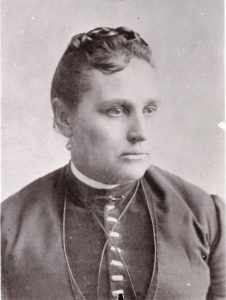 Jane was the daughter of Horace Roberts, who was famously the potter of Nauvoo and later one of the first potters in Utah territory. Jane’s journey of a plural wife showcases yet another situation where there was some wisdom in practice.
Jane was the daughter of Horace Roberts, who was famously the potter of Nauvoo and later one of the first potters in Utah territory. Jane’s journey of a plural wife showcases yet another situation where there was some wisdom in practice.
She originally married in 1852 to a man named Thomas Wheeler. Together they had two children before Thomas abandoned her.
James married Jane in 1856 and would have 11 more children with her. Jane was a devote wife and, like her husband, was absolutely invested in her Mormon faith. Their children lived well into the 20th century and built a legacy of love and faith.
A surviving letter exists that historians say likely dates from the early 1880s between James Chauncey Snow and his first wife, Eliza. He was evidently incarcerated at this time.
“My dear companion . . . to think of your lonesome hours—your sorrow and sighing torn from friends and home—deprived of liberty—it destroys all my happiness. . . . If it was in my power I would decree all the [United States] soldiers so far back to hell that they would never find their way out. . . . I feel like standing up and defending Mormonism all the day long.”
~ What ever happened Anna Clark? ~
In 1863 Anna Clark got her wish and married her true love, Solomon Hale.
Together they would raise eight children while pioneering in far Northern Utah.
It seems that Ann was destined to marry a busy and influential man. Solomon, despite the fears of Ann’s parents, settled down to an adventurous, productive and distinguished life.
Perhaps he was classed as “too wild” while a young man due to his love of horses and his skills with livestock. As a young man Sol partnered with the largest stockman in Utah and learned the cattle trade. Later he took a job breaking horses for the Pony Express Company.
After Sol and Ann married they settled Bear Lake where Sol bought land in nearby Liberty. He worked to expand his herds and within a few years became very successful.
As he grew in influence he began to take on larger roles in the communities where they lived. He served as a Bishop in Idaho before he was called by the Church to be the superintendent over the construction of the Oneida Stake Academy at Preston.
There the family became deeply embedded in the community where Solomon later became a counselor in the Stake Presidency and later the Mayor of Preston.
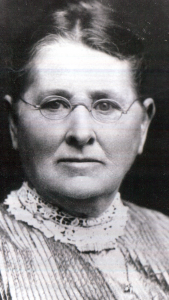 Anna Hale likewise was a prominent individual in the communities where they lived. Aside from church service and raising her children Ann served as the community doctor and midwife whose services were in constant demand. She would never accept pay for her services.
Anna Hale likewise was a prominent individual in the communities where they lived. Aside from church service and raising her children Ann served as the community doctor and midwife whose services were in constant demand. She would never accept pay for her services.
The level of love and service Ann rendered to others was recognized by many. When she died in 1914 President Joseph F. Smith sent Apostle Orson F. Whitney to speak at her funeral.
Ironically, Ann had to make the decision whether or not her husband would enter into plural marriage. This he did in 1873 when he married Jane Clark Bollwinkel – Ann’s sister. Jane had lost her husband a few years before and he had lost a business that left their family deep in debt and saw Jane and her children working at the Utah Woolen Mill.
For their decision to marry into polygamy the Hales – Solomon, Ann and Jane were regularly harassed by federal authorities and lived in constant fear.
~ Honoring the Plural Relationships ~
There is a tendency with modern historians and casual observers of Mormon polygamy to whitewash the real conditions during the latter half of the 19th century. Mormon men are often depicted as cruel abusers and sex fiends while Mormon women engaged in polygamous relationships were thought of as weak, subservient and unprincipled.
While there no doubt existed abusive relationships among some polygamous peoples we see almost none of that evident in the polygamous relationships of our ancestors.
Edwin Westover had two faithful wives who, due to his church service, lived most of their days almost as single mothers – raising children and running farms. Both Sarah and Ann Westover lived for years after Edwin died, true to their end in their covenants with him and with God.
In fact, the plural marriages among the Westovers, Smiths and Snows seemed to produce rare levels of love.
The unexpected marriage of Albert Smith to Sophie Petersen not only brought children to their legacy but also years of temple worship and boundless examples of forgiveness and family service.
Both Ane Marie Jensen and Samuel Barnhurst were rejected of their families – people they deeply loved – because of their faith. They built a life together after starting as complete strangers who couldn’t even converse. Was it faith that destroyed their family past? Or was it faith that built a forever family?
For those who struggle with the reality of plural marriage in Church history I would encourage that you study not only the histories of those who engaged in it but also study the histories of their children. You will witness an elevated understanding of not only faith but also of love.
Note: Several months ago in preparation for a lesson at Church I stumbled upon a record of a vision about the afterlife given to a man named Heber Hale. It’s quite a read. Then a few weeks ago I started working on this connection between James C. Snow and Anna Hale. I couldn’t help but wonder if Heber and Anna were related. They are. She is his mother.

